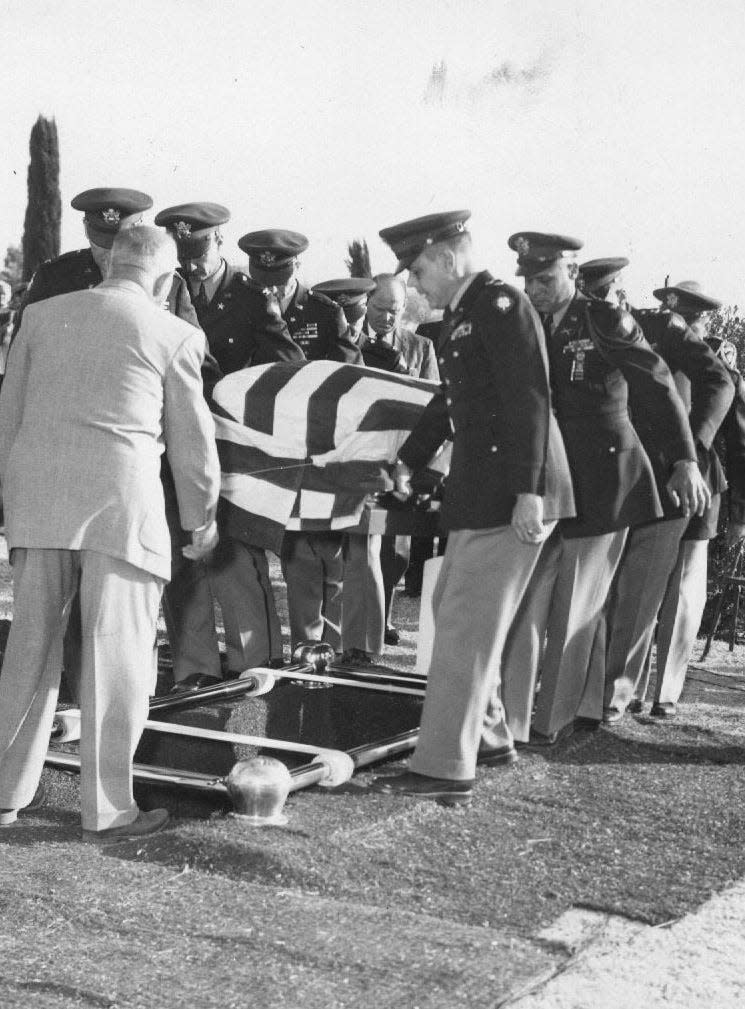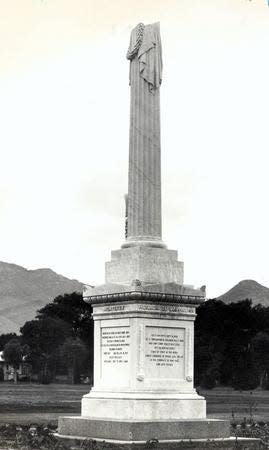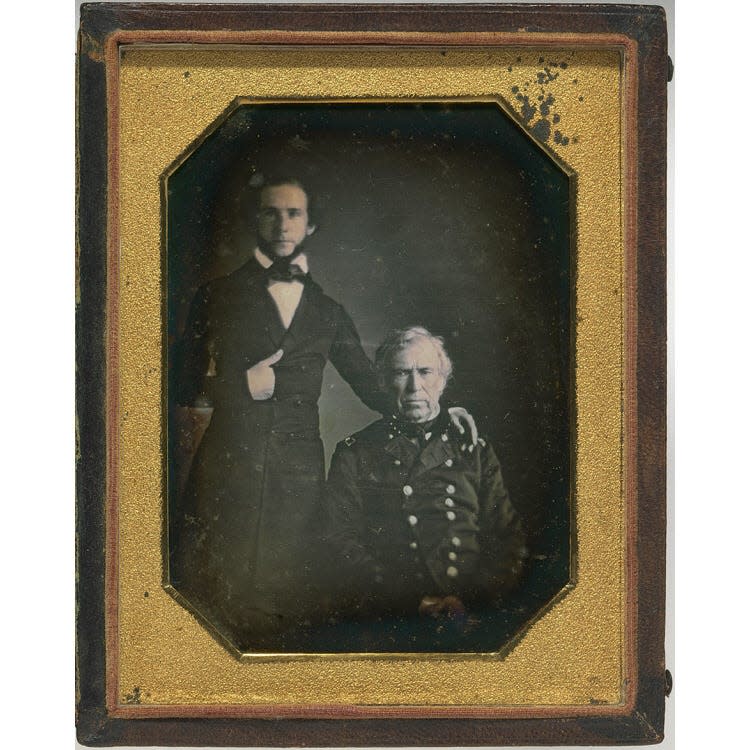Col. Bliss' remains found, returned to El Paso in 1955: Trish Long

In the news 50 years ago, Aug. 7, 1973, was a wreath-laying ceremony at Ft. Bliss on the monument to Lt. Col. William Wallace Smith Bliss for whom the post was named in January 1854. When the National Cemetery was dedicated March 17, 1940, it also carried his name.
The occasion was the 120th anniversary of Bliss’ death on August 5, 1853.
Bliss, who died of yellow fever, was buried in Giron Street Cemetery in New Orleans. After the Army decided to move his remains to the post named in his honor, it was discovered that his casket was not where it was supposed to be. It took almost five years to find his remains.
Col. Bliss' remains found, returned to El Paso in 1955
Push to relocate Col. Bliss begins
In 1950, Maj. Gen. John L. Homer, commanding general of Fort Bliss, put his support behind bringing Bliss' remains to El Paso for burial.
This is from an Aug. 31, 1950, article:
"The move started with the discovery that vandals were destroying crypts and monuments on the Girod Cemetery in New Orleans. ...
"General Homer sent a telegram to General William Barriger, head of the logistics branch of the War department and in charge of the Quartermaster and Graves Registration units.
"He told General Barriger of the desecration at New Orleans, and asked that action be taken to obtain approval of the project. The Graves Registration branch, General Homer said, would attend to all necessary details, including obtaining the consent of surviving descendants of Colonel Bliss.
"The project would be abandoned if such descendants disapproved of the transfer.
"General Homer said the remains of the colonel could be brought to either the National cemetery or a spot more centrally located in the fort. A site near Memorial Circle has been suggested."
More: El Paso County Law Enforcement Memorial Wall honors deputies killed in line of duty: Trish Long
Casket could not be located
Plans to bring the remains of Bliss hit a snag when his casket was unable to be located beneath his monument.
Dec. 9, 1950: "Detector Indicates No Bliss Casket"
"The Fourth Army used an underground detector to determine that there is no metal casket buried beneath the monument to Lt. Col. William Wallace Smith Bliss in Girod Cemetery, New Orleans. ...
"Since there is no casket there, it is believed from a search of church records, which also failed to show evidence of burial, that Colonel Bliss was never buried there. However, the Army said there is consideration being given by the City of New Orleans to moving the entire cemetery...
"If the cemetery is abandoned, Army officials said a more thorough search will be inaugurated for the burying place of Colonel Bliss."
More: First atom bomb test: 'It was just like the sun had come up and suddenly gone down again'
Casket in a concrete and brick tomb
Nearly five years later, on Nov. 11, 1955, it was announced that the colonel's remains were located:
"Ft. Bliss authorities, who have been hunting the colonel's grave for five years, said the casket was in a concrete and brick tomb four feet beneath a monument in Girod Street Cemetery.
"The casket was taken to a New Orleans mortuary, where it will remain until arrangements are made to bring the colonel's remains here for burial in the Ft. Bliss National Cemetery with honors. The body of the man for whom Ft. Bliss was named, Col. William Wallace Smith Bliss, will arrive in El Paso in about 10 days, according to Maj. L. B. Anderson, Ft. Bliss Public Information officer. ...

Scraps of flag remain on the body
"Lieut. Col. T. N. Chavez, deputy chief of staff, for operations at the post here, handled much of the research on seeking Colonel Bliss' body. Lieut. Col. Robert W. Sanders, executive officer to the post quartermaster, went to New Orleans about 10 days ago to supervise the dismantling of the Bliss monument. New Orleans military personnel did the actual dismantling work with the aid of civilian experts.
"Army searchers some time ago discovered that Col. Bliss was likely buried in New Orleans. Colonel Bliss died in 1853 at the age of 38 in Pascagoula, Miss. His. Body apparently was taken by boat for burial in New Orleans.
"When the Bliss monument — a 20-foot shaft which bears the names of the battles in which Colonel Bliss distinguished himself during the Mexican War — was discovered, it was believed his body must be under it.
"Colonel Bliss' features were recognizable from photographs. Scraps of a flag remain on the body. The body is well preserved."
More: March 23, 2003: 2 dead, 8 missing, 5 POW: 507th Maintenance Company from Fort Bliss ambushed
Brief and simple military ceremony
Bliss was buried at Fort Bliss National Cemetery on Nov. 22, 1955:
"A brief and simple military ceremony guided Lt. Col. W.W.S. Bliss to his final resting place in Ft. Bliss National Cemetery.
The body of the scholarly Army officer, which has lain in an all but forgotten grave for more than 100 years, was reburied in a place of honor at the military post named in his memory. ...
"Col. Bliss's body arrived in El Paso shortly after noon Tuesday.
"The casket, draped in an American flag and watched over by two members of the Ft. Bliss honor guard, lay in state at Union Passenger Depot until the solemn military procession began at 2:30 p.m.
"The procession, which included the top officers of Ft. Bliss, moved slowly through El Paso to the military post and came to a halt in the center of National Cemetery.

Graduated West Point at 17
"Lt. Col. William Wallace Smith Bliss was graduated from West Point at the age of 17.
"He was a scholar who was master of six languages and had a reading knowledge of 13. He was a soldier who fought against the Indians in Florida and Santa Anna's men in the Mexican War.
"As an administrator he was assistant adjutant general to Gen. Zachary Taylor and later adjutant general of the Western Division.
"He was the private secretary and right-hand man when Gen. Taylor became President of the United States. Col. Bliss married Taylor's youngest daughter. ...
Final prayer
"The Rev. F. Bernard Henry, chief chaplain at Ft. Bliss, declared that Col. Bliss had 'served his country well as a good and courageous solider.'
"In a final prayer, the chaplain said simply. 'We recommit this body to repose beside his comrades in arms.'
"Following a rifle salute by the honor guard, M.Sgt. Roger S. McCabe played taps at the graveside and S/3c Elton Toning sounded an echo taps in the distance."
Trish Long may be reached at tlong@elpasotimes.com or 915-546-6179.
This article originally appeared on El Paso Times: Col. Bliss' remains found, returned to El Paso in 1955: Trish Long

